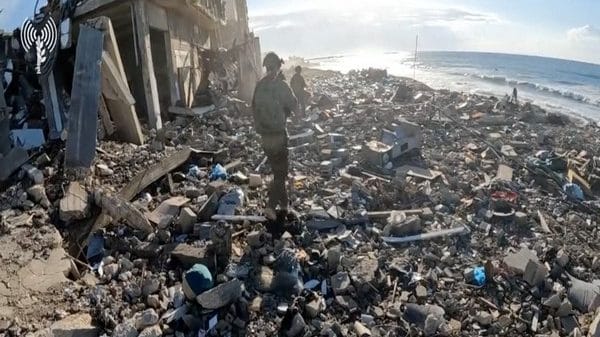Thank you dear subscribers, we are overwhelmed with your response.
Your Turn is a unique section from ThePrint featuring points of view from its subscribers. If you are a subscriber, have a point of view, please send it to us. If not, do subscribe here: https://englishdev.theprint.in/subscribe/
The term ‘insurgency’ has faded off from the lexicon of statecraft, to be replaced by ‘terrorism’. The factor attributing to this, is perhaps the dilution of the agency of ‘people’ vis a vis the motivations behind insurgencies. The Robin Hood image of a guerrilla fighter robbing the haves for have-nots is old school. The world has witnessed the evolution of insurgent or terror groups from leftist ideology based movements till the 80s that had no religious callings, to hard core religion and ethnicity based groups. In tandem as religion and ethnicity solidified the identity of the terror groups, the sheer capabilities of these groups have sky-rocketed, especially in the region of West Asia. The asymmetry between these organised, and yet irregular groups and the states have shrunk considerably. The terror face of outfits like Houthis, Hezbollah, Hamas etc is merely the military wing of the overall governance infrastructure that these outfits have in place.
Hezbollah is a Shiite militant group based in Lebanon, where its extensive security apparatus, political organisation, and social services network have fostered its reputation as “a state within a state.” In addition to the group’s kinetic activities towards its goal, Hezbollah manages a vast network of social services that have been instrumental in garnering support from Shiite and non-Shiite Lebanese alike.
Hamas, much in news these days, is an Islamist militant movement and one of the Palestinian territories’ two major political parties. Armed activities by the group against Israel are undertaken by the military wing of the governing body that is in place in Gaza. It governs more than two million Palestinians in the Gaza Strip.
In the context of ongoing conflicts, it’s essential to understand the role of various militant groups. For instance, Hamas has been a significant player in the Israeli-Palestinian conflict, while the Houthi rebels have also made headlines for their actions in Yemen and beyond.
Iran is widely accused of backing the Houthis, a Shiite movement that has been fighting Yemen’s Sunni-majority government since 2004. The current military conflict between the Saudi-led coalition and Yemeni Houthi rebels has been ongoing since March 2015. The capabilities of Houthi rebels in the field of missile and aerospace include Burkan-3 and Badr-1 ballistic missiles, Quds-2 cruise missiles and various short and long range drones with range upto thousands of kilometres like, Shahed-136, Samad-3 and Qasef-2k. Their third dimension aerospace capability was well demonstrated by aerial attacks on 14 September 2019, wherein drones were used to attack oil processing facilities at Abqaiq and Khurais in Saudi Arabia. The capabilities of Houthis pose a major challenge to the modern air defence systems possessed by states like Saudi Arabia and UAE.
The terror groups, be it Hamas, Houthis, Hezbollah amongst others, have come of age and are positioned on equal footing with the states; not to mention Taliban that is a state now. Asymmetries in such conflicts are diminishing and to add to woes, the states are willing to escalate relentlessly. The tenet of proportionality has been thrown out of the window, in contravention to International Humanitarian Laws. The ego of a state is too big perhaps, to be seen underperforming in an asymmetric war, in spite of history being replete with such examples. The situation for civilians sandwiched in such imbroglios is indeed hopeless.
The issues at stake between the parties to conflict have hardened with time, since conflict management was prioritised over conflict resolution. It is well acknowledged as also an established fact that resolutions can only be accomplished through non military means. For the sake of long term resolution, roots need to be explored but talking about root causes is equated with justifying terror; so obviously, we are at a dead end. No mention of Hamas or terrorism in the UN resolution for humanitarian truce was taken as justification of terror.
India has been facing the challenges of insurgency and terror since the decades of 50s. As a nation, we have done reasonably well by containing this menace in a commendable manner. Our methodology to counter terror has been of restrain, patience and is people centric. The non state actors that make our security situation challenging are indeed of a different hue than the ones in West Asia. Notwithstanding the above, the crucial lesson that the raging conflicts in West Asia bring out, is to make an effort to resolve conflicts, beyond their management. We have had insurgencies and terrorism festering in India for as long as 50 to 60 years, in varying intensity. These challenges, except for Maoism, are primarily in our border states, with our neighbours’ instigating and exploiting the circumstances. In view of the networked character of terror, collusions, inspirations and support systems that often manifest seamlessly, the time for a longer haul towards permanent resolution is now. Truth and reconciliation may be the way ahead.
Colonel Shashank Ranjan (retired) is a retired Infantry Officer with rich experience of serving in counter terrorism. He presently teaches in OP Jindal Global University
These pieces are being published as they have been received – they have not been edited/fact-checked by ThePrint.


